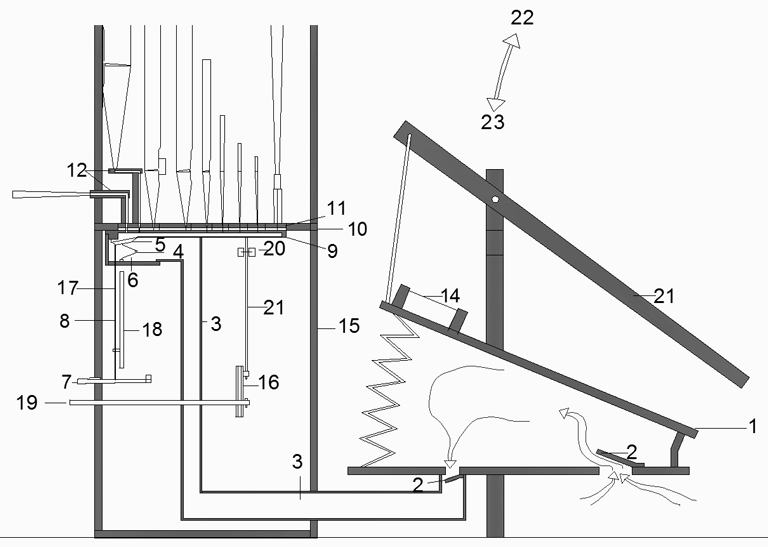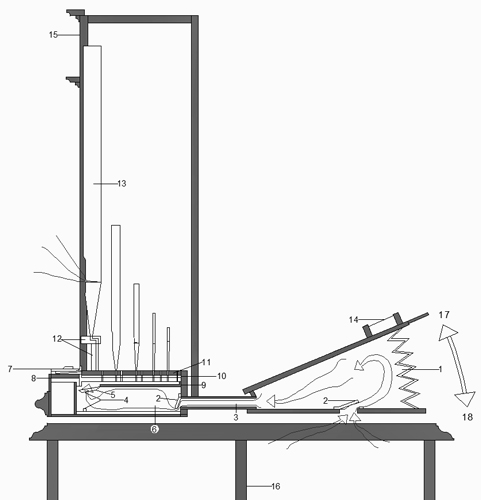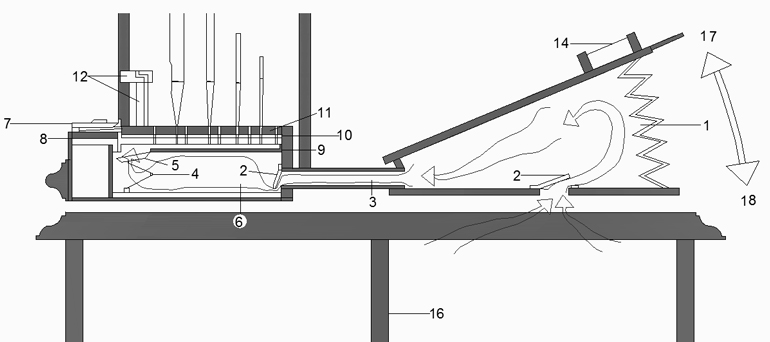1 Bellows |
2 Valve |
3 Wind trunk |
4 Spring |
5 Pallet |
6 Pallet box |
7 Key |
8 Tracker |
9 Groove |
10 Slider |
11 Toe board |
| |
|
 |
12 Grooved board |
14 Weight |
16 Trundle |
17 Roller |
18 Roller board |
19 Stop knob |
20 Pivot |
21 Stop action backfall |
22 Air enters bellows |
23 Air enters organ |
| |
|
When the bellows (1) are raised manually, air (wind) enters them through the feeder valve (2). The bellows slowly deflate, pushed down by their weights (14), which sends air through the wind trunk (3) towards the pallet box (6) at a predetermined pressure.
When depressed, each key (7) pulls down its corresponding pallet or valve (5), allowing the air stored under pressure to be directed through channels in the wind chest to the corresponding pipes (13). Grooves (9), sliders (10) and toeboards (11) together make up the wind chest.
The pipes sound because of the combination of the wind system (bellows, wind trunk, wind chest), key action (key, tracker, pallets) and stop action (slider tabs, sliders).
Each register or row of pipes is controlled by pushing or pulling the slider tabs which protrude from the sides of the organ (10). These move the interior sliders sideways and allow the air to pass from the wind chest to a particular rank of the pipes, if sound is desired, or to close off the air passage if those pipes are not meant to sound.
ORGANS WITH SUSPENDED ACTION
San Jerónimo Tlacochahuaya
La Basílica de la Soledad
La Catedral de Oaxaca
San Matías Jalatlaco
Santo Domingo Yanhuitlán
La Asuncion de María Tlacolula
DIRECT ACTION
1 Bellows |
2 Valve |
3 Wind trunk |
4 Spring |
5 Pallet |
6 Pallet box |
7 Key |
8 Tracker |
9 Groove |
|
 |
10 Slider |
11 Toe board |
12 Grooved board |
13 Pipe |
14 Weight |
15 Case |
16 Table |
17 Air enters bellows |
18 Air enters organ |
|
To print a quality version of this schematic, download direct_action.pdf (744 KB)
DIRECT ACTION (ENLARGEMENT)
1 Bellows |
2 Valve |
3 Wind trunk |
4 Spring |
5 Pallet |
6 Pallet box |
7 Key |
8 Tracker |
|
 |
9 Groove |
10 Slider |
11 Toe board |
12 Grooved board |
14 Weight |
16 Table |
17 Air enters bellows |
18 Air enters organ |
|
When the bellows (1) are raised manually, air (wind) enters them through the feeder valve (2). The bellows slowly deflate, pushed down by their weights (14), which sends air through the wind trunk (3) towards the pallet box (6) at a predetermined pressure. When depressed, each key (7) pulls down its corresponding pallet or valve (5), allowing the air stored under pressure to be directed through channels in the wind chest to the corresponding pipes (13).
Grooves (9), sliders (10) and toeboards (11) together make up the wind chest.
The pipes sound because of the combination of the wind system (bellows, wind trunk, wind chest), key action (key, tracker, pallets) and stop action (slider tabs, sliders).
Each register or row of pipes is controlled by pushing or pulling the slider tabs which protrude from the sides of the organ (10). These move the interior sliders sideways and allow the air to pass from the wind chest to a particular rank of the pipes, if sound is desired, or to close off the air passage if those pipes are not meant to sound.
ORGANS WITH DIRECT ACTION
San Andrés Zautla
Sta. Ma. de la Natividad Tamazulapan
San Andrés Huayapam
San Pedro Mártir Yucuxaco
San Pedro Quiatoni
San Dionisio Ocotepec |

